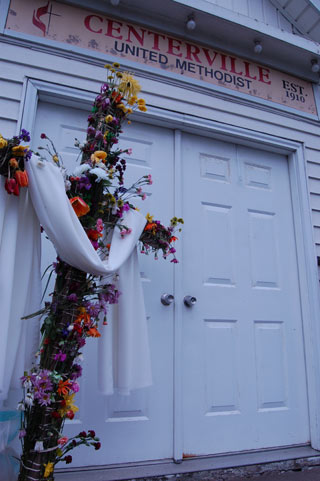Human Flower Project
Thursday, April 12, 2007
Flowering Cross
To symbolize the Resurrection of Jesus, should living flowers cover the cross at Easter?

Centerville United Methodist Church
Centerville, Kentucky (Bourbon County)
4/11/07, three days after Easter
Photo: Human Flower Project
After the austerity of Lent, many Christian denominations go all out with Easter decorations. In the US (perhaps elsewhere, too) Presbyterian, Methodist, Lutheran and Episcopalian churches take off Lent’s mournful purple, drape the altar in white and cover the cross with fresh flowers. Long ago, we remember toddling up near the baptismal font Easter Sunday with a daffodil from the yard and placing it in a cross-shaped armature covered in chickenwire. It seems to have become customary in many Southern Methodist churches to place a bare cross outside the doors of the sanctuary, and as members of the congregation gather Easter morning, each leaves a bloom on the cross.
Floral demonstrations like this don’t resolve into a single meaning, of course, but the flowered cross on Easter clearly does suggest the Resurrection. Some churches, as they announce Easter services, even make this meaning explicit. We’ve found Lutherans in Indiana and Presbyterians in Texas, and the Reformed Church of St. Croix, in the Virgin Islands, all celebrated Easter with flowered crosses this year, three among many thousands to do so.
Catholics and Baptists seem less inclined to ornament the cross (we hope that readers can tell us why).
After a wet and chilly few days, the blooms had drooped on the cross at Centerville United Methodist Church but still shone three days after Easter against the white front door. The town earned its name for being at the crossroads of four larger Central Kentucky towns: Lexington, Paris, Georgetown, and Cynthiana. Of all places, at all times, Centerville surely warrants an outdoor flowered cross for Easter.




